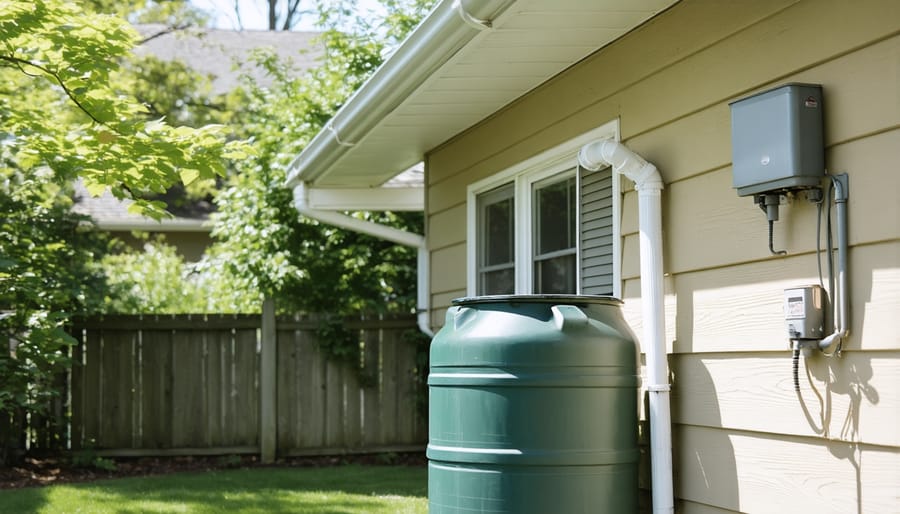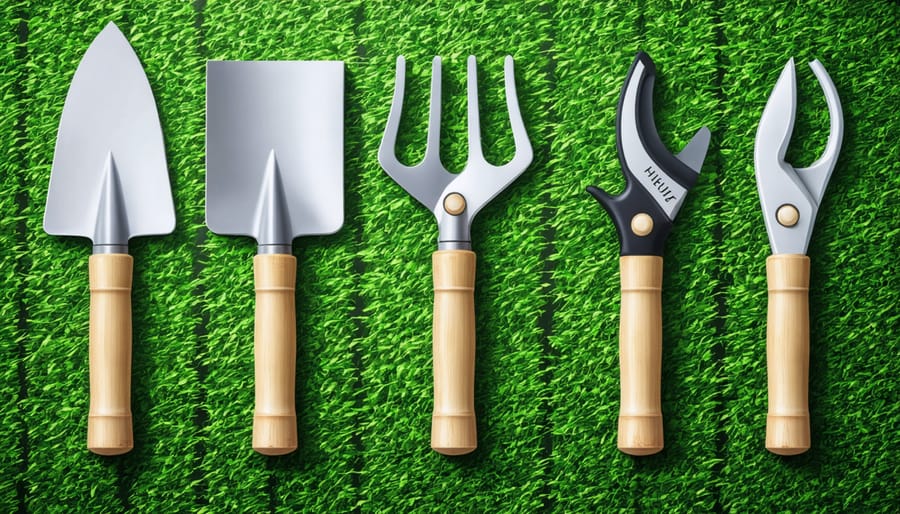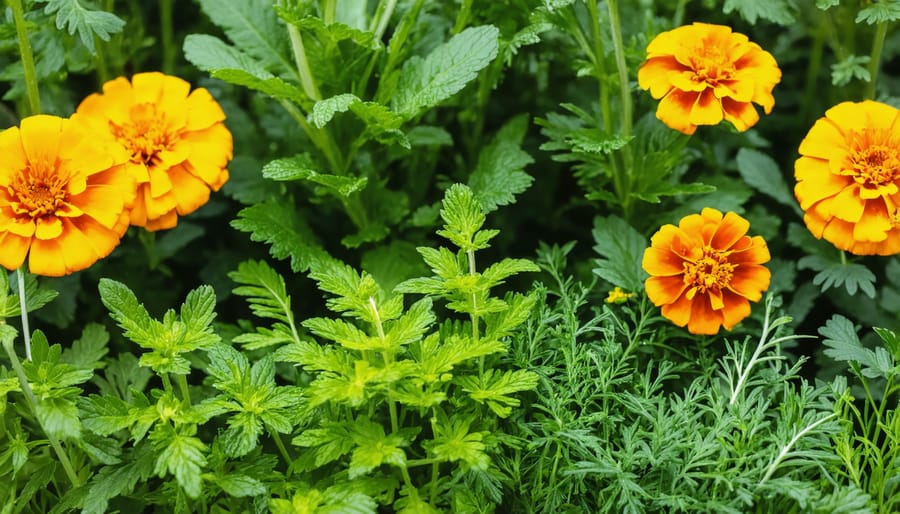Transform your outdoor space into a thriving, sustainable sanctuary by implementing smart eco-friendly gardening practices. Install a rainwater harvesting system with connected drip irrigation to reduce water consumption by up to 70%. Create rich, living soil through composting kitchen scraps and yard waste, eliminating the need for chemical fertilizers. Choose native plants and eco-friendly products that naturally resist local pests while supporting pollinators and beneficial insects.
Build biodiversity by layering plants of different heights and blooming seasons, creating a self-sustaining ecosystem that requires minimal intervention. Incorporate vertical gardening techniques to maximize space efficiency and improve air circulation, reducing disease pressure naturally. Use recycled materials for garden beds, pathways, and borders, minimizing environmental impact while adding character to your outdoor space.
By following these sustainable practices, you’ll create a garden that not only looks beautiful but also contributes positively to the environment, reduces maintenance costs, and provides a healthy habitat for local wildlife.
Smart Water Management Solutions That Actually Work
Rain Collection Systems Worth Your Money
Investing in a quality rain collection system is one of the smartest moves you can make for your eco-friendly garden. The RainHarvest Pro 50-gallon barrel leads our recommendations, offering an excellent balance of capacity and practicality for most home gardens. Its UV-resistant material prevents algae growth, while the mesh screen keeps debris and mosquitoes out.
For those with larger gardens, the EcoSmart Collection System 100-gallon unit features a modular design that lets you connect multiple barrels as your needs grow. The built-in overflow protection and easy-access spigot make it particularly user-friendly, even for gardening newcomers.
Don’t overlook simple DIY options, either. A food-grade 55-gallon drum fitted with a debris filter and spigot can be just as effective as premium models at a fraction of the cost. Just ensure you elevate your barrel on a stable platform to improve water pressure.
For apartment dwellers or those with limited space, consider the compact Urban Rain Saver 20-gallon system. It fits neatly against walls and includes a collapsible diverter that connects directly to your downspout.
Pro tip: Whatever system you choose, add a first-flush diverter to prevent the initial roof runoff (which often contains more debris) from entering your collection barrel. This small addition significantly improves your stored water quality and extends the life of your system.

Smart Irrigation Tools That Save Water and Time
Modern gardening doesn’t have to mean choosing between a thriving garden and water conservation. Today’s smart irrigation solutions make it easier than ever to maintain a beautiful garden while being environmentally conscious.
Smart water controllers are game-changers for eco-friendly gardening. These devices connect to your local weather data and automatically adjust watering schedules based on rainfall, temperature, and seasonal changes. Some models even learn from your garden’s specific needs over time, ensuring optimal water usage without waste.
Drip irrigation systems are another excellent investment, delivering water directly to plant roots where it’s needed most. These systems reduce water consumption by up to 70% compared to traditional sprinklers and help prevent common issues like fungal growth and weed proliferation.
Soil moisture sensors are simple yet effective tools that take the guesswork out of watering. These affordable devices alert you when plants actually need water, preventing both under and over-watering. Pair them with smart controllers for a fully automated system that responds to real-time soil conditions.
Rain barrels and gray water systems help maximize water efficiency by collecting and reusing water that would otherwise go to waste. Installing a simple rain barrel under your downspout can provide free water for your garden throughout the growing season, while more advanced gray water systems can repurpose household water for irrigation.
Remember to group plants with similar water needs together and water during early morning or evening hours to minimize evaporation. These smart tools, combined with thoughtful planning, create an efficient and sustainable watering system that saves both time and resources.
Earth-Friendly Tools That Last for Years

Manual Tools That Outperform Power Equipment
While power tools might seem like the obvious choice for gardening tasks, traditional manual tools often prove more efficient, eco-friendly, and satisfying to use. A well-made hand trowel, for instance, offers precise control for planting and weeding that electric alternatives simply can’t match. Plus, it never needs charging or maintenance beyond basic cleaning.
The humble push reel mower deserves special mention. Modern versions are lightweight, require minimal maintenance, and cut grass just as effectively as gas-powered mowers – all while providing a peaceful, emissions-free mowing experience. They’re particularly effective for small to medium-sized lawns and create that satisfying striped pattern many gardeners love.
For pruning and trimming, bypass pruners and loppers often outperform their electric counterparts. They allow for more precise cuts, which promotes better plant health, and you can easily reach tight spaces that power tools might struggle with. Manual hedge shears, while requiring more physical effort, provide better control and create cleaner cuts without the risk of accidental damage.
The classic rake remains unbeatable for leaf collection and soil preparation. Unlike leaf blowers, rakes are silent, don’t disturb neighbors, and actually help you build upper body strength while gardening. They’re also excellent for dethatching lawns and spreading mulch evenly.
Hand tools offer additional benefits beyond performance: they’re typically more durable, require no fuel or electricity, produce zero emissions, and create a more mindful gardening experience. By choosing manual tools, you’re not just making an environmentally conscious choice – you’re often selecting the most effective tool for the job.
Solar-Powered Garden Equipment That Delivers
Ready to harness the power of the sun in your garden? Solar-powered tools have come a long way, offering eco-conscious gardeners reliable alternatives to traditional gas-guzzling equipment. As part of the growing trend toward energy-efficient garden equipment, these innovative tools combine sustainability with functionality.
Let’s start with solar-powered lawn mowers, which have become increasingly popular among eco-friendly gardeners. The Greenworks Solar Mower Pro stands out with its 90-minute runtime and impressive cutting power. What’s even better? It charges fully in just four hours of direct sunlight, making it perfect for weekend maintenance.
For nighttime garden ambiance, solar string lights and path markers are game-changers. The LightMax Solar Garden Series offers both practical illumination and decorative charm, with built-in sensors that automatically activate at dusk.
Water management becomes effortless with solar-powered irrigation systems. The SunFlow Smart Watering System combines moisture sensors with solar-powered pumps, ensuring your plants get exactly what they need while conserving water. It’s particularly effective during dry spells and can reduce water usage by up to 40%.
Don’t overlook smaller tools like solar-powered pruning shears and weed zappers. The SunCut Pruning Pro offers three hours of continuous use from a single charge, while the WeedAway Solar Wand uses concentrated sunlight to eliminate weeds without chemicals.
When choosing solar garden tools, consider your specific needs and climate. Look for products with backup battery options for cloudy days, and check the warranty – quality solar equipment should last for years with proper care.
Sustainable Materials for Your Garden Space
Recycled and Sustainable Planters
Transform your garden into an eco-conscious oasis by choosing sustainable planters that give new life to everyday materials. Old wooden crates, once destined for the landfill, make charming raised beds after a quick sand and seal. Wine barrels cut in half offer rustic charm while keeping industrial materials out of waste streams.
Get creative with household items: Convert worn-out toolboxes, old boots, or vintage colanders into unique herb gardens. Even plastic milk jugs and food-grade buckets can become practical planters – just remember to drill drainage holes and clean thoroughly before use.
For a modern aesthetic that’s still earth-friendly, look for planters made from recycled plastics or bamboo composite materials. These options are durable, weather-resistant, and help reduce plastic waste. Clay and terracotta pots, while not recycled, are natural materials that can last decades with proper care.
Consider vertical gardening with repurposed pallets or create stunning wall gardens using recycled guttering. Old metal watering cans and vintage kitchen containers add character while serving a new purpose. For larger projects, explore local salvage yards for materials like reclaimed stone or concrete pieces that can be transformed into permanent garden features.
Remember to check that any repurposed containers are food-safe if you’re planning to grow edibles, and ensure proper drainage to maintain plant health. With a bit of creativity, you can create beautiful, sustainable container gardens while reducing waste.
Natural Mulch and Ground Cover Solutions
Natural mulch and ground cover options are your garden’s best friends when it comes to sustainability. Instead of using synthetic materials, opt for organic mulch like shredded leaves, grass clippings, or wood chips – materials you can often source for free from your own yard or local tree services.
A 2-3 inch layer of organic mulch helps retain soil moisture, regulate temperature, and suppress weed growth naturally. As these materials break down, they enrich your soil with valuable nutrients, creating a self-sustaining cycle that benefits your garden’s ecosystem.
Consider these eco-friendly ground cover solutions:
– Fallen leaves: Collect and shred autumn leaves to create nutrient-rich mulch
– Straw: Perfect for vegetable gardens and excellent for moisture retention
– Pine needles: Ideal for acid-loving plants and provides long-lasting coverage
– Compost: Use as a thin top layer to boost soil health
– Living ground covers: Plant low-growing species like creeping thyme or sedum
Pro tip: Layer cardboard or newspaper underneath your mulch for extra weed control. These materials naturally decompose while providing an additional barrier against unwanted plants.
Remember to refresh your mulch layer annually, and avoid piling it against plant stems or tree trunks to prevent rot. By choosing natural ground covers, you’re not just maintaining your garden – you’re contributing to a healthier soil ecosystem and reducing waste.

Chemical-Free Pest Control That Actually Works
Keeping your garden pest-free doesn’t mean you need to resort to harmful chemicals. There are plenty of effective natural pest control methods that protect both your plants and the environment.
Companion planting is your first line of defense. Marigolds naturally repel harmful insects while attracting beneficial pollinators. Plant them around your vegetables and watch them work their magic. Lavender, basil, and mint are other excellent pest-deterrent plants that double as wonderful herbs for your kitchen.
For larger pests like rabbits and deer, physical barriers work wonders. We’ve tested several garden nets and found the ultra-fine mesh netting from GardenGuard to be particularly effective. It’s durable, easy to install, and doesn’t harm wildlife – just keeps them at a safe distance from your precious plants.
Beneficial insects are your garden’s best friends. Ladybugs, praying mantises, and parasitic wasps naturally control pest populations. You can purchase these helpful creatures from reputable suppliers or attract them naturally by growing flowering plants like yarrow and dill.
Neem oil has proven to be a game-changer in our testing. This natural insecticide effectively controls aphids, mealybugs, and other common garden pests without harming beneficial insects. Mix one tablespoon with a quart of water and spray affected plants weekly.
DIY solutions can be surprisingly effective too. A simple mixture of water and mild dish soap sprayed on affected plants helps control soft-bodied insects. For slugs, a shallow dish of beer works like a charm – they’re attracted to the yeast and won’t bother your plants.
Remember to maintain healthy soil and proper plant spacing. Strong, well-nourished plants naturally resist pests better than stressed ones. Regular monitoring helps catch problems early, making natural solutions more effective.
Creating an eco-friendly garden is not just a trend – it’s a meaningful way to contribute to environmental sustainability while enjoying the beauty and bounty of nature. Throughout this guide, we’ve explored various aspects of maintaining a garden that works in harmony with the environment, from water conservation techniques to natural pest control methods.
Remember that every small step counts. Start by implementing water-saving practices like mulching and installing a rainwater collection system. Choose native plants that naturally thrive in your climate and support local wildlife. Opt for hand tools over gas-powered equipment when possible, and embrace organic gardening methods that avoid harmful chemicals.
As you develop your eco-friendly garden, focus on creating a balanced ecosystem. Companion planting, composting, and encouraging beneficial insects will help your garden flourish naturally. Don’t feel pressured to transform your entire garden overnight – start with manageable changes and gradually expand your sustainable practices.
The rewards of an eco-friendly garden extend beyond environmental benefits. You’ll likely notice lower water bills, healthier plants, and an increase in beneficial wildlife visiting your garden. Plus, you’ll have the satisfaction of knowing you’re contributing to a healthier planet while creating a beautiful, sustainable outdoor space.
Take the first step today by implementing one or two of these eco-friendly practices. Your garden – and the environment – will thank you for it.
